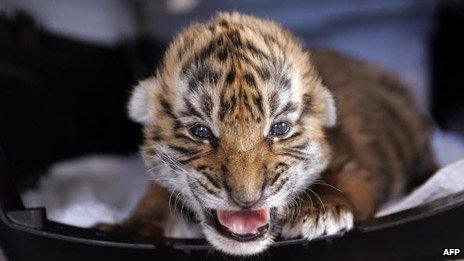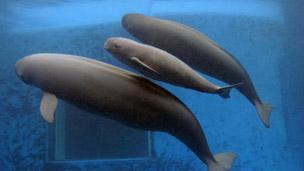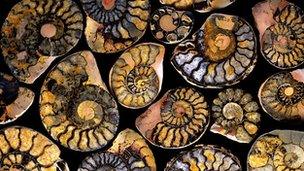Biodiversity loss: How accurate are the numbers?
- Published

Now found only in captivity, the South China Tiger
Twenty years ago, the Earth Summit in Rio resulted in a Convention on Biological Diversity, now signed by 193 nations, to prevent species loss. But can we tell how many species are becoming extinct?
One statement on the Convention's website claims: "We are indeed experiencing the greatest wave of extinction since the disappearance of the dinosaurs."
While that may (or may not) be true, the next sentence is spuriously precise: "Every hour three species disappear. Every day up to 150 species are lost."
Even putting aside the apparent mathematical error in that claim (on the face of it, if three species are disappearing every hour, 72 would be lost every day) there is an obvious problem in generating any such number. No-one knows how many species exist. And if we don't know a species exists, we won't miss it when it's gone.
"Current estimates of the number of species can vary from, let's say, two million species to over 30 or even 100 million species," says Dr Braulio Dias, executive secretary of the Convention on Biological Diversity. "So we don't have a good estimate to an order of magnitude of precision," he says.
It is possible to count the number of species known to be extinct. The International Union for Conservation of Nature (IUCN) does just that. It has listed 801 animal and plant species (mostly animal) known to have gone extinct since 1500.
But if it's really true that up to 150 species are being lost every day, shouldn't we expect to be able to name more than 801 extinct species in 512 years?
Professor Georgina Mace, who works in the Centre for Population Biology at Imperial College London, says the IUCN's method is helpful but inadequate. "It is never going to get us the answers we need," she says. That's why scientists prefer to use a mathematical model to estimate species loss.
Recently, however, that model has been attacked in the pages of Nature. Professor Stephen Hubbell from the University of California, Los Angeles, says that an error in the model means that it has - for years - over-estimated the rate of species loss.

Animal charisma: The Yangtze finless porpoise is a relative of the extinct Baiji river dolphin
The model applies something called the "species to area relationship" to habitat loss. Put simply, an estimate is made of the number of species in a given area, or habitat - the larger the area, the greater the number of species are said to be in it.
Then the model is worked backwards - the smaller the area, the fewer the species. In other words, if you measure habitat loss, you can use the model to calculate how many species are being lost as that habitat gets smaller.
The problem, says Hubbell, is that the model does not work in reverse. "The method," he says, "when extrapolated backward, doesn't take into account the fact that you need to remove more area to get to the whole range of a species than you need to remove area to find the first individual of a species."
Hubbell's point is that if you increase a habitat by, say, five hectares, and your calculations show that you expect there to be five new species in those five hectares, it is wrong to assume that reversing the model, and shrinking your habitat, eliminates five species.
That's because it takes more area to establish extinction - to show that every individual in a species has been eliminated - than it does to discover a new species, which requires coming across just one individual of that species. Hubbell says when corrected the model shows about half as many species going extinct as previously reported.
Unfortunately for scientists trying to measure species loss, the problems don't end there. They also need to calculate the 'background rate' of extinction. If you want to work out the impact of human life on biodiversity, you need to know how many species would have gone extinct anyway without us being here. Mace says that is difficult.
"Background rates are not constant either," she says. "If you look back through the history of life on Earth, there have been major periods of extinctions. Extinction rates vary a lot."
The level of uncertainty faced by researchers in this field means it is perhaps not surprising that no-one can be sure of the scale of species loss. It also means that when a representative of the Convention of Biological Diversity claimed "every hour three species disappear" he must have known it was too precise.
But the fact that the precise extinction rate is unknowable does not prove that the problem is imagined.
Braulio Dias, executive secretary of the Convention on Biological Diversity, says: "We know that the drivers behind species loss are mostly increasing - land conversion and degradation, pollution, climate change. And of course the human population is still growing and consumption is growing - and most of that consumption is not sustainable."
Professor Hubbell, too, thinks species loss is a serious issue, even though he believes it has been exaggerated.
There is, though, one other problem faced by anyone who wants to call attention to the issue - the fear that people are inclined to care more about so-called charismatic animals (mostly larger animals which we recognise) than the millions of nameless and microscopic organisms which are also included in species loss models.

Not all extinct molluscs are fossils
Hubbell says we should be at least as concerned about such seemingly unimportant species.
"The proportion of the world's species that are charismatic organisms is really tiny," he says. "From a biomass point of view, this is a bacterial planet. It's a very parochial view to assume that we should care only about elephants and zebras."
But if people do care more about charismatic animals than bacteria, which seems likely, then it might prove difficult to get those people to take the issue seriously unless such animals are threatened.
A number of charismatic species, or sub-species, have become extinct in the wild, but have been kept alive in captivity thanks to the efforts of enthusiasts and campaigners.
Others have gone extinct - like the Pyrenean Ibex or the Baiji river dolphin. But compared to the number of species which exist in the world, even taking the lowest estimates of that number, such known cases are very few.
According to IUCN data, for example, only one animal has been definitely identified as having gone extinct since 2000. It was a mollusc.
<italic>Additional reporting by Polly Hope</italic>